
The allegory of the long spoons is a parable that shows the difference between heaven and hell by means of people forced to eat with long spoons. It is attributed to Rabbi Haim of Romshishok, as well as other sources. [1]

The allegory of the long spoons is a parable that shows the difference between heaven and hell by means of people forced to eat with long spoons. It is attributed to Rabbi Haim of Romshishok, as well as other sources. [1]
The allegory can be summarized as follows:
In each location, the inhabitants are given access to food, but the utensils are too unwieldy to serve oneself with. In hell, the people cannot cooperate, and consequently starve. In heaven, the diners feed one another across the table and are sated.
The story can encourage people to be kind to each other. There are various interpretations of the fable including its use in sermons and in advice to lonely people.
The story suggests that people have the opportunity to use what they are given (the long spoons in this allegory) to help nourish each other, but the problem, as Haim points out, lies in how people treat each other. [1]
Given the same level playing field one group of people who treat each other well will create a pleasant environment, whereas another group of people, given exactly the same tools to work with, can create unpleasant conditions simply by how they treat each other. Writer Dawn Eden suggests that this is a simple truth which can be easily forgotten by lonely people unable to see their situation clearly. She argues that such situations can be improved by reaching out to others. [2] The long spoons allegory has been associated with crab mentality. Specifically, exam scores are now anonymous in New Zealand, to reduce bullying by peers. [3]
The long spoons allegory has become part of the folklore of several cultures, for example: Jewish, [4] Hindu, [5] Buddhist, [6] "Oriental" (Middle-Eastern) [7] and Christian. [2] [8] In medieval Europe, the food in the story is a bowl of stew; in China, it is a bowl of rice being eaten with long chopsticks. [1]
In some versions of the story, the diners are using regular cutlery but are unable to bend their arms, [1] with a story attributed to Rabbi Haim of Romshishok describing how "both arms were splinted with wooden slats so he could not bend either elbow to bring the food to his mouth".
One variant of the allegory was used by the League of Nations to assist with postwar peace after World War I. [9]
While the parable itself is seldom depicted in art, it is well known and used in sermons when referring to hell, where the fashion for depicting hell in terrible, painful, gruesome terms is fading in recent times. [2]
The parable is told by Norman McCay in the novelization of Kingdom Come . In the 2011 Boardwalk Empire episode "Under God's Power She Flourishes", Father Brennan tells Margaret the allegory of the long spoons while Emily is fitted for leg braces. [10] A scene in the 2013 thriller The East draws strong comparisons to the allegory when protagonist Sarah is depicted as selfish for neglecting to feed her adjacent diner while in a straitjacket. It is also retold in Barbara Kingsolver's novel The Bean Trees . The plot of 2019's The Platform has also been compared to the allegory. [11]
Caritas made a short animated video based on this allegory for their campaign "One human family, food for all". [12]
The visit of the second ghost in the 1997 film Ms. Scrooge has been compared to the long spoons allegory. [13]
The Asian version of the proverb is told by the character Bode in The Simpsons episode "Warrin' Priests". [14]

As a literary device or artistic form, an allegory is a narrative or visual representation in which a character, place, or event can be interpreted to represent a meaning with moral or political significance. Authors have used allegory throughout history in all forms of art to illustrate or convey complex ideas and concepts in ways that are comprehensible or striking to its viewers, readers, or listeners.
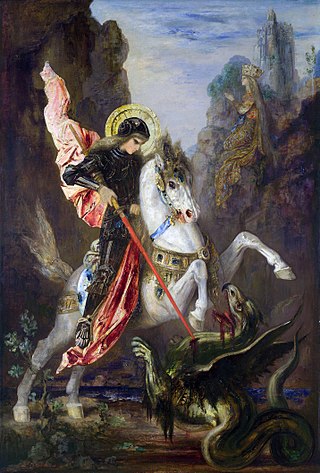
Christian mythology is the body of myths associated with Christianity. The term encompasses a broad variety of legends and narratives, especially those considered sacred narratives. Mythological themes and elements occur throughout Christian literature, including recurring myths such as ascending a mountain, the axis mundi, myths of combat, descent into the Underworld, accounts of a dying-and-rising god, a flood myth, stories about the founding of a tribe or city, and myths about great heroes of the past, paradises, and self-sacrifice.

Heaven, or the heavens, is a common religious cosmological or transcendent supernatural place where beings such as deities, angels, souls, saints, or venerated ancestors are said to originate, be enthroned, or reside. According to the beliefs of some religions, heavenly beings can descend to Earth or incarnate and earthly beings can ascend to Heaven in the afterlife or, in exceptional cases, enter Heaven without dying.

In cutlery or kitchenware, a fork is a utensil, now usually made of metal, whose long handle terminates in a head that branches into several narrow and often slightly curved tines with which one can spear foods either to hold them to cut with a knife or to lift them to the mouth.

The parable of the Good Samaritan is told by Jesus in the holy Gospel of Luke. It is about a traveler who is stripped of clothing, beaten, and left half dead alongside the road. First, a Jewish priest and then a Levite come by, but both avoid the man. Finally, a Samaritan happens upon the traveler. Although Samaritans and Jews were generally antagonistic towards each other, the Samaritan helps the injured man. Jesus is described as telling the parable in response to a provocative question from a lawyer, "And who is my neighbor?", in the context of the Great Commandment. The conclusion is that the neighbor figure in the parable is the one who shows mercy to their fellow man and/or woman.

A parable is a succinct, didactic story, in prose or verse, that illustrates one or more instructive lessons or principles. It differs from a fable in that fables employ animals, plants, inanimate objects, or forces of nature as characters, whereas parables have human characters. A parable is a type of metaphorical analogy.

A diner is a type of restaurant found across the United States and Canada, as well as parts of Western Europe. Diners offer a wide range of foods, mostly American cuisine, a casual atmosphere, and, characteristically, a combination of booths served by a waitstaff and a long sit-down counter with direct service, in the smallest simply by a cook. Many diners have extended hours, and some along highways and areas with significant shift work stay open for 24 hours.

Hungry ghost is a term in Buddhism, and Chinese traditional religion, representing beings who are driven by intense emotional needs in an animalistic way. The terms 餓鬼èguǐ literally "hungry ghost", are the Chinese translation of the term preta in Buddhism which is a Sanskrit word. "Hungry ghosts" play a role in Chinese Buddhism and Taoism as well as in Chinese folk religion. The term is not to be confused with the generic term for "ghost" or damnation, 鬼guǐ. The understanding is that all people become such a regular ghost when they die, and would then slowly weaken and eventually die a second time.

The Palazzo Pubblico is a palace in Siena, Tuscany, central Italy. Construction began in 1297 to serve as the seat of the Republic of Siena's government, which consisted of the Podestà and Council of Nine, the elected officials who performed executive functions. The palace is of medieval and Gothic architecture, and the interior is lined with frescoes--most importantly, the collection known as The Allegory of Good and Bad Government by Ambrogio Lorenzetti.
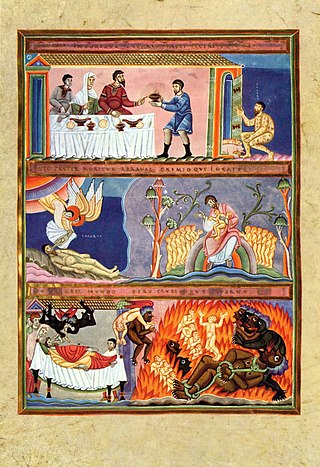
The rich man and Lazarus is a parable of Jesus from the 16th chapter of the Gospel of Luke. Speaking to his disciples and some Pharisees, Jesus tells of an unnamed rich man and a beggar named Lazarus. When both die, the rich man goes to Hades and implores Abraham to send Lazarus from his bosom to warn the rich man's family from sharing his fate. Abraham replies, "If they do not listen to Moses and the Prophets, they will not be convinced even if someone rises from the dead."

The Parable of the Ten Virgins, also known as the Parable of the Wise and Foolish Virgins or the Parable of the ten bridesmaids, is one of the parables of Jesus. According to Matthew 25:1–13, ten virgins await a bridegroom; five have brought enough oil for their lamps for the wait, while the oil of the other five runs out. The five virgins who are prepared for the bridegroom's arrival are rewarded, while the five who went to buy further oil miss the bridegroom's arrival and are disowned.
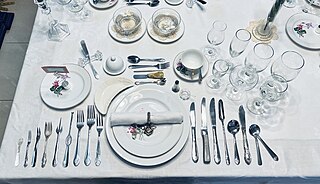
A full-course dinner is a meal with multiple courses, almost invariably eaten in the evening or afternoon. Most Western-world multicourse meals follow a standard sequence, influenced by traditional French haute cuisine. It commonly begins with an appetizer, followed by the main course, the salad course, and eventually the dessert, but the exact sequence varies widely. Full-course dinners are generally very formal as well as very expensive, and can have as few as 3 or as many as 21 courses. Some major styles include service à la russe and service à la française.
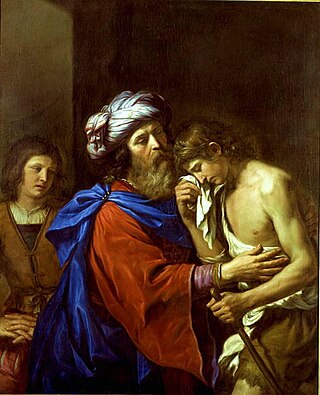
The parables of Jesus are found in the Synoptic Gospels and some of the non-canonical gospels. They form approximately one third of his recorded teachings. Christians place great emphasis on these parables, which they generally regard as the words of Jesus.

Table manners are the rules of etiquette used while eating, which may also include the use of utensils. Different cultures observe different rules for table manners. Each family or group sets its own standards for how strictly these rules are to be followed.

The Parable of the Weeds or Tares is a parable of Jesus which appears in Matthew 13:24–43. The parable relates how servants eager to pull up weeds were warned that in so doing they would root out the wheat as well and were told to let both grow together until the harvest. Later in Matthew, the weeds are identified with "the children of the evil one", the wheat with "the children of the Kingdom", and the harvest with "the end of the age". A shorter, compressed version of the parable is found without any interpretation in the apocryphal Gospel of Thomas.

The parable of drawing in the net, also known as the parable of the dragnet, is a Christian parable that appears in the Gospel of Matthew, chapter 13, verses 47–52. The parable refers to the Last Judgment. This parable is the seventh and last in Matthew 13, which began with the parable of the Sower. It directly follows the Parable of the Pearl, which is about the Kingdom of God. Thus, it links the Kingdom of God with the final judgment—the separation for hell and heaven.

In religion and folklore, hell is a location or state in the afterlife in which souls are subjected to punitive suffering, most often through torture, as punishment after death. Religions with a linear divine history often depict hells as eternal destinations, the biggest examples of which are Christianity and Islam, whereas religions with reincarnation usually depict a hell as an intermediary period between incarnations, as is the case in the Dharmic religions. Religions typically locate hell in another dimension or under Earth's surface. Other afterlife destinations include heaven, paradise, purgatory, limbo, and the underworld.
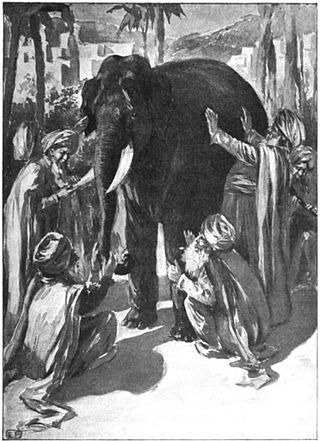
The parable of the blind men and an elephant is a story of a group of blind men who have never come across an elephant before and who learn and imagine what the elephant is like by touching it. Each blind man feels a different part of the animal's body, but only one part, such as the side or the tusk. They then describe the animal based on their limited experience and their descriptions of the elephant are different from each other. In some versions, they come to suspect that the other person is dishonest and they come to blows. The moral of the parable is that humans have a tendency to claim absolute truth based on their limited, subjective experience as they ignore other people's limited, subjective experiences which may be equally true. The parable originated in the ancient Indian subcontinent, from where it has been widely diffused.

Crab mentality, also known as crab theory, crabs in a bucket mentality, or the crab-bucket effect, is a way of thinking usually described by the phrase "if I can't have it, neither can you".